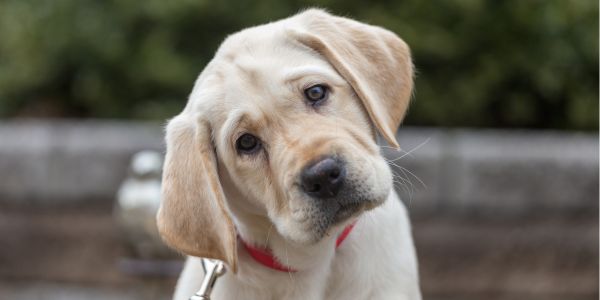Have you noticed that your dog’s occiput is getting bigger? Also known by other flamboyant names like “knowledge bump,” “love knot,” “smart knot,” and “smart bump,” an occiput on a dog’s head is a normal part of its anatomy. Your dog’s occiput grows and increases in size, in proportion to its skull.
So, seeing a small smart knot on your dog’s head is not necessarily a cause for concern. But, seeing the bump on top of your dog’s head getting bigger every day is a major cause for concern. A disproportionately sized dog skull bump typically indicates a serious underlying medical condition.
In this article, I will tell you everything you need to know about occiputs on dog skulls. By the end of this article, you will learn exactly what to do to prevent the bump on top of your dog’s head from getting any bigger.
Do you have a specific question about dog occiput? Then use the table of contents below to jump to the most relevant section. And you can always go back by clicking on the black arrow in the right bottom corner of the page. Also, please note that some of the links in this article may be affiliate links. For more details, check the Disclosure section at the bottom of the page.
Here's what we'll cover:
What Is an Occiput on a Dog
The terms “occipital bone” and “occipital bump” often get confused. So, let me clarify certain things: The occipital bone is a large bone that makes up the back of your dog’s skull. An occipital bump is a small lump/protrusion on the surface of the larger occipital bone.
- The term “occiput” has its roots in the Latin phrase for “back of the skull.”
- The bone that makes up the entire back of your dog’s skull is called the occipital bone.
- This flat bone protects key parts of your dog’s brain, namely the cerebellum and the brainstem. It also serves as a safe passage for the dog’s spinal cord.
- An occiput bump in a dog is a bony lump at the back of the skull, on the surface of the occipital bone.
- Occipital bumps are caused by the thickening of bone at the back of the skull.
- This thickening is not abnormal. It is caused by various factors like genetics, head injuries, dog breed, etc.
- Things start getting abnormal only when the knowledge bump on your dog’s head keeps increasing in size.
Dogs from different breeds develop occiputs of different sizes. Some dog breeds have the propensity to naturally grow pronounced occiputs while others have smaller occiput bumps all throughout their lives.
Since the occiput is a normal part of your dog’s anatomy, it should remain consistent in size throughout its dog’s life. During this period, the occiput will serve a few key purposes for your dog:
- The occipital bone is directly connected to your dog’s neck. The occipital bump is the region through which the nerve endings of your dog’s spinal cord run to connect with its brain. Indirectly, the occipital bump helps your dog move his/her head freely.
- Historically, the occiput has helped protect dogs’ skulls from bites and attacks from predators.
- Since the occiput plays a key role in facilitating your dog’s head movements, it is a great spot to massage. This region of the skull is full of nerve endings. Massaging this bump can deliver great comfort to your dog.
What Dog Breeds Have A Bump on Their Head?
Do all dogs have an occiput? Yes. Although the size/shape of the occiputs always varies depending on the dog’s breed, they are ever-present on the skulls of dogs. In some dogs, the occiput is more noticeable. In others, you may have to rub your hands on the dogs’ skulls to find the bump. The average length of an occiput is approximately 2.5 cm.
However, the larger the dog breed, the bigger the size of the occiput on their head. So, there are many large dog breeds that have occiputs way lengthier and bigger than 2.5 cm. For example, Bloodhounds, with an average size of 4.0 cm have some of the largest occipital bumps in the canine kingdom.
Here is a chart detailing the size of the prominent occipital bone and bump in different dog breeds:
| Dog Breed | Average Occiput Size |
| All Dogs | 2.5 cm |
| Bloodhound | 4.0 cm |
| Labrador Retriever | 3.0 cm |
| Golden Retriever | 3.0 cm |
| English Setter | 3.5 cm |
| English Pointer | 3.0 cm |
| Collie | 2.5 cm |
| Cocker Spaniel | 2.0 cm |
| Basset Hound | 3.5 cm |
| Doberman Pinscher | 3.0 cm |
| German Shepherd | 3.0 cm |
What to Do If Bump on Dogs Head Getting Bigger
Sudden changes in the size/shape of your dog’s occiput could be a symptom of an underlying health condition. Contact your veterinarian if the swollen occipital bone on your dog’s head is displaying the following symptoms:
- The bump is warm and sensitive to the touch
- If the bump is causing noticeable pain and discomfort in your dog
- The bump is swollen and loose; it can be moved around with your hands
The main reason behind the rise of these frustrating symptoms is muscle atrophy. Your dog has probably lost a lot of muscle around the back of their skull. This muscle mass loss has resulted in your dog’s head becoming bony and the occiput becoming more prominent.
Key Risks to Be Worried About
There are many reasons why dogs lose muscle mass around their skulls. From cancer to poor appetite issues: there is a long list of diseases that can cause severe muscle atrophy in dogs. The most common disease in this list is Masticatory Muscle Myositis (MMM)
Myositis is an immune system disorder that can be caused by a variety of factors, including viral infections, parasitic infections, genetic disposition, and cancer. MMM causes dogs to identify their own muscle tissue as foreign agents.
When the immune system attacks its own muscle tissues, swelling and inflammation are caused in the dog’s occiput. If your dog’s head bump has been appearing larger than normal, check for the following symptoms of MMM:
- Inability to chew due to pain in the jaw
- Sunken eyes
- Dizziness
- Vomiting
- Unable to support its own weight
- Dragging limbs on the floor
- Severe weight loss
The best way to confirm the root cause behind your dog’s head bump is to get an official diagnosis from the vet. The vet will perform a series of blood and physical tests. The results of these tests will be used to give customized care to your four-legged friend!
Thanks for the blog graphics: Canva.com
Thanks for the blog graphics: Canva.com
Doghint.com is a participant of several affiliate programs. The list includes (but not limited to) the following: VigLink, Refersion, ShareASale, and Amazon Services LLC Associates Program, an affiliate advertising program designed to provide a mean for us to earn fees by linking to Amazon.com and affiliated sites. Doghint.com does not intend to provide veterinary advice. All published articles are meant for informational purposes only and not substitute the professional veterinary consultation.


